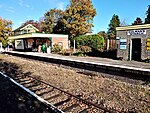Norfolk ( NOR-fək) is a ceremonial county in the East of England and East Anglia. It borders Lincolnshire and The Wash to the north-west, the North Sea to the north and east, Cambridgeshire to the west, and Suffolk to the south. The largest settlement is the city of Norwich.
The county has an area of 2,074 sq mi (5,370 km2) and a population of 859,400. It is largely rural with few large towns: after Norwich (147,895), the largest settlements are King's Lynn (42,800) in the north-west, Great Yarmouth (38,693) in the east, and Thetford (24,340) in the south. For local government purposes Norfolk is a non-metropolitan county with seven districts.
The west of Norfolk is part of the Fens, an extremely flat former marsh. The centre of the county is gently undulating lowland; its northern coast is an area of outstanding natural beauty, and in the south is part of Thetford Forest. In the east are the Broads, a network of rivers and lakes which extend into Suffolk. The area is protected by the Broads Authority and has similar status to a national park. The geology of the county includes clay and chalk deposits, which make its coast susceptible to erosion.
There is evidence of Prehistoric settlement in Norfolk. In the Roman era the region was home to the Iceni, whose leader Boudica led a major revolt in AD60. The Angles settled the area in the fifth century, and it became part of the Kingdom of East Anglia. During the later Middle Ages the county was very prosperous and heavily involved in the wool trade; this allowed the construction of many large churches. In 1549 Norfolk was the scene of Kett's Rebellion, which unsuccessfully protested the enclosure of land. The county was not heavily industrialised during the Industrial Revolution, and Norwich lost its status as one of England's largest cities. The contemporary economy is largely based on agriculture and tourism.









